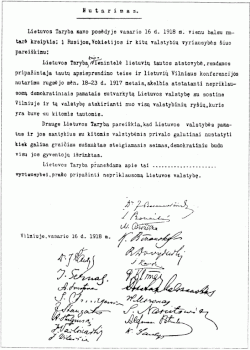Vladas Mironas
Vladas Mironas (born June 22, 1880 in Kuodiškiai , Rokiškis district , † February 18, 1953 in Vladimir , Soviet Union ) was a Lithuanian Catholic priest , politician and Prime Minister for one year . He campaigned for the independence of Lithuania and died in a Soviet prison after the country was occupied by the Red Army .
Life
Degree and Catholic priest
Mironas first visited the Mintaujos- School of Jelgava , which is also the first President of Lithuania ( Antanas Smetona ) and his predecessor as prime minister Juozas Tūbelis completed. In 1897 he began studying at the Roman Catholic Seminary in Vilnius , which he graduated in 1901. He then completed further studies at the Academy of Saint Petersburg , which he finished in 1904 with a master's degree in theology .
After his ordination in 1904, he worked as a priest in Vilnius . This was followed by activities as a priest in Choroszcz in Poland , Valkininkai and Daugai . In 1907 he became a member of the Lithuanian Scientific Society ( Lietuvių mokslo draugija ). From 1914 to 1929 he was dean of the deanery of Merkinė .
Political career
independence
In addition to his work as a priest, Mironas was politically active at an early stage. On December 4th and 5th, 1905, he was a participant in the Great Seimas of Vilnius, influenced by the events of the Russian Revolution . This was the first modern congress in Lithuania, which mainly dealt with national issues. Ultimately, the Great Seimas decided on extensive autonomy within the Russian Empire .

From September 18 to 22, 1917 he was a participant in the National Conference of Vilnius , at which the process of establishing a Lithuanian state independent of the Russian Empire, Poland and the German Empire began. In addition, on July 11, 1918, the National Conference elected the Lithuanian National Council (Lietuvos Valstybės Taryba) consisting of 20 members, and subsequently became its second vice-president. On November 2, 1918, the National Council proclaimed the independence of Lithuania, the resolution of which was signed on February 16, 1918.
Subsequently, he was mainly active again as dean of Merkinė. After the Smetona coup on December 17, 1926, he was re-elected as a member of the Seimas . After the dissolution of the Seimas in 1929, he worked again as a priest at the Archangel Michael Church in Kaunas and as the chief military chaplain.
Prime Minister and Soviet occupation
On March 24, 1938 he was appointed as the representative of the Lietuvių Tautos Pažangos Partija of Smetona as the successor of Juozas Tūbelis during a government crisis with Poland as Prime Minister. His government followed the political goal of an understanding deal with Poland. In particular, fair treatment of the Polish minority was promised. Finally, it was announced that on November 12, 1938, both states would present news on the radio and in the press in the spirit of good neighborliness.
He held the post of prime minister until his replacement by Jonas Černius on March 28, 1939. From October 1 to December 5, 1938, he was also Minister of Agriculture . At the end of his term of office, Lithuania had to bow to German pressure in March 1939 and cede the Memel area back to Germany .
During the Second World War , after the occupation of Lithuania by the Red Army , he was arrested on September 12, 1940 and sentenced to forced labor in the central prison of Kaunas. On June 23, 1941 he was liberated by the Lithuanian Activist Front (Lietuvos Aktyvistų Frontas), which declared Lithuania's independence on the same day. However, after the invasion of the German Wehrmacht on September 26, 1941, the activist front was banned. In 1945 he was arrested again and then forced to cooperate with the Soviet People's Commissariat for Internal Affairs (NKVD). However, his work in Vilnius was so unsatisfactory for the NKVD that he was soon arrested again and taken to a prison in Vladimir , where he later died.
Web links
- Biography on the Seimas homepage
- Biography on the government homepage (Lithuanian)
- Biography on the homepage of the National Museum (Lithuanian)
- Biographical information in rulers.org
Individual evidence
- ↑ Great Seimas of Vilnius in the English language Wikipedia.
- ^ Lithuania's Road To Regain Its Sovereignty And Establish A Democratic Republic . In: LITUANUS - Lithuanian Quarterly Journal Of Arts And Sciences, Issue 32, 1986.
- ^ Robert A. Vitas: The Polish-Lithuanian Crisis Of 1938 - Events Surrounding The Ultimatum . In: LITUANUS - Lithuanian Quarterly Journal Of Arts And Sciences, Issue 30, 1984.
- ↑ news.iblogger.org/1938-lithuania.html
- ↑ Homepage of the Ministry of Agriculture ( page no longer available , search in web archives ) Info: The link was automatically marked as defective. Please check the link according to the instructions and then remove this notice. (Lithuanian)
| predecessor | Office | successor |
|---|---|---|
| Juozas Tūbelis |
Prime Minister of Lithuania March 24, 1938 - March 28, 1939 |
Jonas Černius |
| personal data | |
|---|---|
| SURNAME | Mironas, Vladas |
| BRIEF DESCRIPTION | Lithuanian priest and prime minister |
| DATE OF BIRTH | June 22, 1880 |
| PLACE OF BIRTH | Kuodiškiai |
| DATE OF DEATH | February 18, 1953 |
| Place of death | Vladimir (Russia) |

